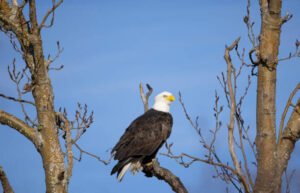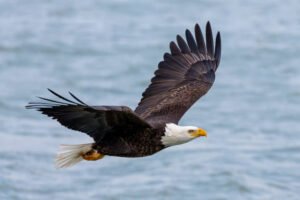
Introduction
The regal Bald Eagle, adorned with its resplendent alabaster crown and piercing gaze, has perpetually ensnared the fascination of nature enthusiasts and patriots alike. Many hold a unique fondness for this emblematic raptor, representing fortitude, liberty, and unwavering determination. Within the confines of this discourse, we embark on an enthralling odyssey to scrutinize the intriguing realm of bald eagles, from their captivating history to their distinctive demeanor and habitat. Prepare your binoculars, for we are poised to embark on a splendid expedition to uncover the enigmatic creatures known as bald eagles.
Historical Narrative
The chronicles of the bald eagle are opulent and riveting. Over epochs, these splendid avian entities have symbolized dominance and emancipation. Indigenous American cultures venerated them as sacred beings, attributing to them spiritual attributes. When these exquisite eagles first graced the skies over North America, they captivated the European colonists, extolled for their robustness, grace, and perspicacity. Sadly, as human activities burgeoned and civilizations expanded, the bald eagle populace waned.
To forestall the jeopardy befalling this renowned species, conservation initiatives were inaugurated in the latter half of the 20th century. The Endangered Species Act played a pivotal role by prohibiting deleterious pesticides such as DDT, which were precipitously decimating their numbers. Today, owing to these conscientious conservation endeavors and the indefatigable stewards committed to their well-being, there is a discernible resurgence in the bald eagle populace.
They remain safeguarded by various statutes, even though their endangered status has been alleviated. The exploration of bald eagles underscores our imperative obligation to coexist harmoniously with nature’s illustrious denizens, concurrently preserving their ecosystems for the edification and gratification of future generations. An increased awareness of these resplendent avian within our natural milieu can be fostered through an understanding of their historical significance.
Habitat and Abode
These majestic bald eagles inhabit an assortment of North American territories, spanning from Alaska to Mexico. These remarkable avian creatures gravitate towards expanses replete with water, such as lakes, rivers, and reservoirs, as well as coastal environs. They typically favor domains abundant in nourishing fare, including piscine or aquatic fowl. Towering trees or precipitous cliffs are prerequisites for the construction of their eyries and aeries. They are more predisposed to dwell in primeval woodlands adjacent to aqueous borders, where they can procure suitable precincts for nesting.

Bald eagles are not restricted solely to littoral zones but also frequent hilly terrains and, at times, urban settings. Their adaptability has facilitated cohabitation with humanity while preserving their natural haunts. Witnessing these resplendent birds ascend the firmament or roost aloft in arboreal perches, overseeing their dominion, is nothing short of breathtaking. Bald eagles inhabit a miscellany of topographies, thus augmenting their allure as one of the most emblematic and potent symbols of freedom within nature’s repertoire.
Dietary Preferences
What composes the culinary predilections of the bald eagles? The diverse and multifarious fare pursued by these majestic avians is a testament to their versatility as apex predators. Bald eagles are predominantly piscivorous, although it might astonish you to discern their proclivity for opportunistic predation. Their sustenance primarily comprises piscine species, with trout and salmon prominently featuring among their favored quarry. During spectacular aerial exhibitions, they employ their keen talons to seize fish either from the water’s surface or mid-flight. However, the dietary spectrum of bald eagles transcends piscine confines.
These remarkable creatures also partake of diminutive mammals, including lagomorphs, sciurids, and juvenile cervids, as exigencies dictate. They have also been observed engaging in scavenging, availing themselves of carrion forsaken by other creatures. In the pursuit of their prey, bald eagles employ astute hunting strategies. They hover high above their quarry before descending abruptly, talons outstretched and primed for a swift strike. Their acumen in vision permits them to detect potential viands from great distances, a critical asset in forage-seeking.
Notably, bald eagles have been known to indulge in kleptoparasites, purloining victuals from other avian species, such as gulls or ospreys. This attests to their resourcefulness and adeptness in seizing opportunities for an uncomplicated repast. The dietary predilections of bald eagles are both diverse and adaptable, encompassing recently captured fish, scavenged carrion, or pilfered repasts from fellow avifauna. These majestic creatures manifest adroit hunting prowess and shrewd survival stratagems.
Nesting Habitats and Ovulation
The vista from a bald eagle’s eyrie is nothing short of awe-inspiring. These magnificent avian species construct their abodes in towering trees, typically in proximity to aquatic features like lakes or rivers. These monumental edifices, predominantly constructed from branches and twigs with soft adjuncts like moss or herbage, can expand to an expanse of five feet, supporting the weight of hundreds of pounds. Bald eagles are acknowledged for the cyclic augmentation of their nests, steadily introducing fresh materials with each visit. Certain eyries have functioned as homesteads for decades, incrementally expanding each year.
Once a nest is realized, it becomes the abode for the eagle pair and their progeny. In the course of each procreative season, bald eagles typically lay between one to three eggs, with both progenitors partaking in the incubation process. These eggs approximate the proportions of chicken eggs and are of an immaculate alabaster hue. An incubation period of approximately 35 days ensues, during which time the parents vigilantly tend to their offspring. Subsequent to hatching, the fledgling eaglets remain dependent on their parental units for sustenance and shelter until achieving the capacity to take to the skies, which typically transpires when they attain an age of 10 to 12 weeks. The nesting comportment of bald eagles underscores their unwavering commitment to familial life and the perpetuation of future generations. The manner in which these avian creatures craft such intricate aeries at prodigious altitudes is truly astounding.
Behavioral Patterns
While the arresting visage and expansive wingspan are well-documented, it is perhaps less known that bald eagles engage in intriguing activities. These birds manifest a breadth of behaviors that are simultaneously captivating and pivotal to their survival. One such behavior is territoriality; they tenaciously safeguard their nesting territories from other eagles or intruders, ensuring an abundant food supply and suitable nesting locales. It is not uncommon to witness aerial clashes between two bald eagles, vying for dominion over a specific terrain.

Additionally, bald eagles display a gamut of captivating behaviors related to their dietary proclivities. As scavengers and opportunistic predators, they consume an array of prey contingent upon what is accessible to them. While fish constitute the majority of their diet, bald eagles have been observed partaking of small creatures, waterfowl, carrion, and even other raptors, such as seagulls. Bald eagle pairs cement enduring unions, often mating for life. They partake in intricate courtship rituals, involving synchronized rapid descents and mid-air talon-grappling. Subsequent to their union, the male and female alternate between foraging for sustenance and nurturing their offspring.
Another commendable attribute exhibited by these remarkable creatures is parental solicitude. Both parental figures play a pivotal role in rearing their young, provisioning them with nourishment, sanctuary, and instruction in the art of proficient flight and hunting. Rearing their progeny spans several months until the fledglings attain autonomy for voyaging. In addition to behaviors linked to survival and reproduction, bald eagle collectives, denominated as convocations or roosts, partake in social interactions that encompass vocalizations such as cries or ululations, along with corporeal signals that convey dominance or submissiveness.
Communication Methods
Communication is an essential facet of existence for every species, and the bald eagle is no exception. These magnificent birds of prey have developed a myriad of distinct modes for communicating with one another. Vocalizations are a primary means through which bald eagles communicate, each call or sound serving a particular purpose. For instance, they might employ a shrill, high-pitched whistling sound to demarcate territory or defend their nesting site. Additionally, bald eagles employ body language and vocalizations as mechanisms of communication. They routinely engage in elaborate aerial exhibitions, performing acrobatic airborne maneuvers or coordinating intricate flight formations. These displays, in addition to accentuating their strength and agility, serve as courtship rituals.

Furthermore, bald eagles rely predominantly on visual signals to communicate with one another. The disposition of their feathers and wings can convey either submissiveness or aggression. An elevated crest may denote vigilance or enthusiasm, while a bowed head signifies capitulation. Moreover, bald eagles employ tactile communication within their familial or communal group. Gentle nudges with their beaks or affiliative actions like feather preening are modes through which they express themselves. The diversity and enthralling nature of bald eagle communication methods are nothing short of remarkable. Through these modalities, they adeptly coordinate foraging and mating endeavors while navigating intricate social dynamics within their collective assemblages.
Conclusion
The Bald Eagle, an enthralling creature, has captured the hearts and imaginations of people worldwide. Its majestic countenance, formidable hunting prowess, and symbolic importance render it a pivotal component of our natural heritage. Through dedicated research and exploration of this wondrous bird, we have gained a deeper insight into the realm of the bald eagle. Much can be gleaned about these remarkable creatures, from their historical significance to ongoing preservation initiatives.
As our endeavors to comprehend and safeguard the bald eagle continue, we must acknowledge the imperative task of preserving their habitats and ensuring their perpetuation for future generations. By taking affirmative action to safeguard their environments and disseminate awareness of their unique attributes, we can ensure that these magnificent birds of prey perpetually symbolize freedom and strength. Hence, the next time a bald eagle graces the heavens or perches in a tree, take a moment to contemplate its magnificence and recollect the progress we have made in comprehending these extraordinary creatures. Let us persist in our pursuit of knowledge, preservation, and protection to ensure the delight of future generations who may bear witness to their majestic flight.
FAQs
Q: Do bald eagles have bald spots?
A: No, bald eagles are not genuinely devoid of feathers, despite their nomenclature. “Bald” emanates from an antiquated English term signifying resplendent or white. Bald eagles feature an illustrious head adorned with glossy feathers that contrast starkly against their ebony plumage.
Q: What is the bald eagle’s lifespan?
A: In the wild, bald eagles can endure for up to two to three decades, although accounts of considerably lengthier lifespans in captivity have been documented.
Q: Do bald eagles remain monogamous for life?
A: Upon discovering a suitable mate, a pair of bald eagles typically sustains a lifelong bond. They collaboratively construct and tend to their nest, jointly partaking in the incubation of their eggs.
Q: Is it possible to observe bald eagles in our vicinity?
A: Owing to dedicated conservation endeavors, bald eagle populations have experienced a remarkable resurgence in recent times. No longer on the brink of extinction, they are now discernible around bodies of water teeming with fish across substantial regions of North America.
Q: What should one do if they encounter an injured or distressed bald eagle?
A: If one happens upon an ailing or disconcerted avian, such as a bald eagle, it is advisable to refrain from approaching it closely, as this may exacerbate its discomfort. The recommended course of action is to contact local wildlife authorities or organizations specialized in avian rescue and rehabilitation, as they possess the expertise required to address such circumstances.





